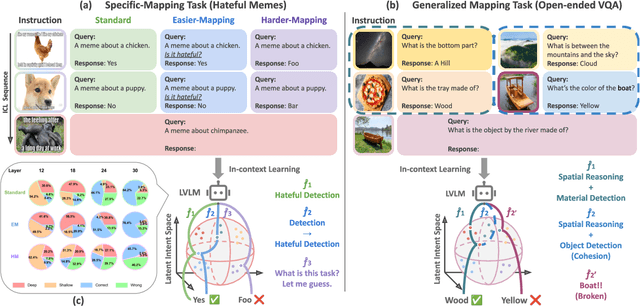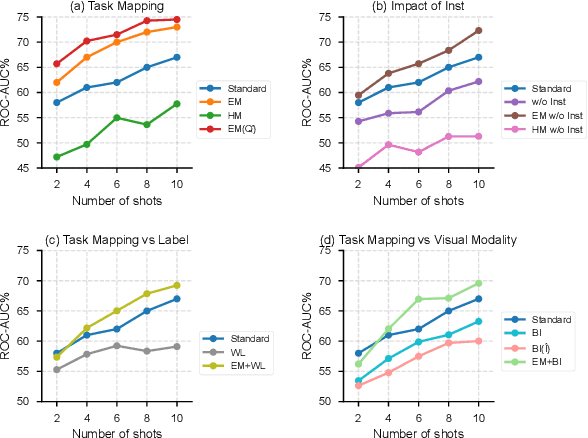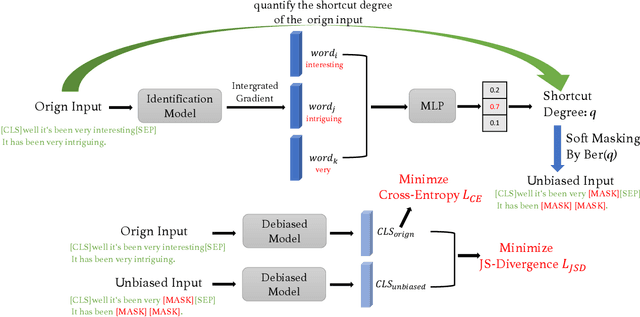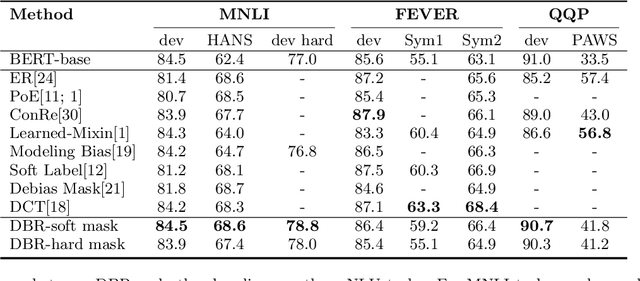Ruixiang Tang
Read the Scene, Not the Script: Outcome-Aware Safety for LLMs
Oct 05, 2025Abstract:Safety-aligned Large Language Models (LLMs) still show two dominant failure modes: they are easily jailbroken, or they over-refuse harmless inputs that contain sensitive surface signals. We trace both to a common cause: current models reason weakly about links between actions and outcomes and over-rely on surface-form signals, lexical or stylistic cues that do not encode consequences. We define this failure mode as Consequence-blindness. To study consequence-blindness, we build a benchmark named CB-Bench covering four risk scenarios that vary whether semantic risk aligns with outcome risk, enabling evaluation under both matched and mismatched conditions which are often ignored by existing safety benchmarks. Mainstream models consistently fail to separate these risks and exhibit consequence-blindness, indicating that consequence-blindness is widespread and systematic. To mitigate consequence-blindness, we introduce CS-Chain-4k, a consequence-reasoning dataset for safety alignment. Models fine-tuned on CS-Chain-4k show clear gains against semantic-camouflage jailbreaks and reduce over-refusal on harmless inputs, while maintaining utility and generalization on other benchmarks. These results clarify the limits of current alignment, establish consequence-aware reasoning as a core alignment goal and provide a more practical and reproducible evaluation path.
CATP: Contextually Adaptive Token Pruning for Efficient and Enhanced Multimodal In-Context Learning
Aug 11, 2025Abstract:Modern large vision-language models (LVLMs) convert each input image into a large set of tokens, far outnumbering the text tokens. Although this improves visual perception, it introduces severe image token redundancy. Because image tokens carry sparse information, many add little to reasoning, yet greatly increase inference cost. The emerging image token pruning methods tackle this issue by identifying the most important tokens and discarding the rest. These methods can raise efficiency with only modest performance loss. However, most of them only consider single-image tasks and overlook multimodal in-context learning (ICL), where redundancy is greater and efficiency is more critical. Redundant tokens weaken the advantage of multimodal ICL for rapid domain adaptation and cause unstable performance. Applying existing pruning methods in this setting leads to large accuracy drops, exposing a clear gap and the need for new techniques. Thus, we propose Contextually Adaptive Token Pruning (CATP), a training-free pruning method targeted at multimodal ICL. CATP consists of two stages that perform progressive pruning to fully account for the complex cross-modal interactions in the input sequence. After removing 77.8\% of the image tokens, CATP produces an average performance gain of 0.6\% over the vanilla model on four LVLMs and eight benchmarks, exceeding all baselines remarkably. Meanwhile, it effectively improves efficiency by achieving an average reduction of 10.78\% in inference latency. CATP enhances the practical value of multimodal ICL and lays the groundwork for future progress in interleaved image-text scenarios.
A Semantic Segmentation Algorithm for Pleural Effusion Based on DBIF-AUNet
Aug 08, 2025Abstract:Pleural effusion semantic segmentation can significantly enhance the accuracy and timeliness of clinical diagnosis and treatment by precisely identifying disease severity and lesion areas. Currently, semantic segmentation of pleural effusion CT images faces multiple challenges. These include similar gray levels between effusion and surrounding tissues, blurred edges, and variable morphology. Existing methods often struggle with diverse image variations and complex edges, primarily because direct feature concatenation causes semantic gaps. To address these challenges, we propose the Dual-Branch Interactive Fusion Attention model (DBIF-AUNet). This model constructs a densely nested skip-connection network and innovatively refines the Dual-Domain Feature Disentanglement module (DDFD). The DDFD module orthogonally decouples the functions of dual-domain modules to achieve multi-scale feature complementarity and enhance characteristics at different levels. Concurrently, we design a Branch Interaction Attention Fusion module (BIAF) that works synergistically with the DDFD. This module dynamically weights and fuses global, local, and frequency band features, thereby improving segmentation robustness. Furthermore, we implement a nested deep supervision mechanism with hierarchical adaptive hybrid loss to effectively address class imbalance. Through validation on 1,622 pleural effusion CT images from Southwest Hospital, DBIF-AUNet achieved IoU and Dice scores of 80.1% and 89.0% respectively. These results outperform state-of-the-art medical image segmentation models U-Net++ and Swin-UNet by 5.7%/2.7% and 2.2%/1.5% respectively, demonstrating significant optimization in segmentation accuracy for complex pleural effusion CT images.
TACO: Enhancing Multimodal In-context Learning via Task Mapping-Guided Sequence Configuration
May 21, 2025



Abstract:Multimodal in-context learning (ICL) has emerged as a key mechanism for harnessing the capabilities of large vision-language models (LVLMs). However, its effectiveness remains highly sensitive to the quality of input in-context sequences, particularly for tasks involving complex reasoning or open-ended generation. A major limitation is our limited understanding of how LVLMs actually exploit these sequences during inference. To bridge this gap, we systematically interpret multimodal ICL through the lens of task mapping, which reveals how local and global relationships within and among demonstrations guide model reasoning. Building on this insight, we present TACO, a lightweight transformer-based model equipped with task-aware attention that dynamically configures in-context sequences. By injecting task-mapping signals into the autoregressive decoding process, TACO creates a bidirectional synergy between sequence construction and task reasoning. Experiments on five LVLMs and nine datasets demonstrate that TACO consistently surpasses baselines across diverse ICL tasks. These results position task mapping as a valuable perspective for interpreting and improving multimodal ICL.
CAMA: Enhancing Multimodal In-Context Learning with Context-Aware Modulated Attention
May 21, 2025Abstract:Multimodal in-context learning (ICL) enables large vision-language models (LVLMs) to efficiently adapt to novel tasks, supporting a wide array of real-world applications. However, multimodal ICL remains unstable, and current research largely focuses on optimizing sequence configuration while overlooking the internal mechanisms of LVLMs. In this work, we first provide a theoretical analysis of attentional dynamics in multimodal ICL and identify three core limitations of standard attention that ICL impair performance. To address these challenges, we propose Context-Aware Modulated Attention (CAMA), a simple yet effective plug-and-play method for directly calibrating LVLM attention logits. CAMA is training-free and can be seamlessly applied to various open-source LVLMs. We evaluate CAMA on four LVLMs across six benchmarks, demonstrating its effectiveness and generality. CAMA opens new opportunities for deeper exploration and targeted utilization of LVLM attention dynamics to advance multimodal reasoning.
M2IV: Towards Efficient and Fine-grained Multimodal In-Context Learning in Large Vision-Language Models
Apr 06, 2025Abstract:Multimodal in-context learning (ICL) is a vital capability for Large Vision-Language Models (LVLMs), allowing task adaptation via contextual prompts without parameter retraining. However, its application is hindered by the token-intensive nature of inputs and the high complexity of cross-modal few-shot learning, which limits the expressive power of representation methods. To tackle these challenges, we propose \textbf{M2IV}, a method that substitutes explicit demonstrations with learnable \textbf{I}n-context \textbf{V}ectors directly integrated into LVLMs. By exploiting the complementary strengths of multi-head attention (\textbf{M}HA) and multi-layer perceptrons (\textbf{M}LP), M2IV achieves robust cross-modal fidelity and fine-grained semantic distillation through training. This significantly enhances performance across diverse LVLMs and tasks and scales efficiently to many-shot scenarios, bypassing the context window limitations. We also introduce \textbf{VLibrary}, a repository for storing and retrieving M2IV, enabling flexible LVLM steering for tasks like cross-modal alignment, customized generation and safety improvement. Experiments across seven benchmarks and three LVLMs show that M2IV surpasses Vanilla ICL and prior representation engineering approaches, with an average accuracy gain of \textbf{3.74\%} over ICL with the same shot count, alongside substantial efficiency advantages.
EAZY: Eliminating Hallucinations in LVLMs by Zeroing out Hallucinatory Image Tokens
Mar 10, 2025Abstract:Despite their remarkable potential, Large Vision-Language Models (LVLMs) still face challenges with object hallucination, a problem where their generated outputs mistakenly incorporate objects that do not actually exist. Although most works focus on addressing this issue within the language-model backbone, our work shifts the focus to the image input source, investigating how specific image tokens contribute to hallucinations. Our analysis reveals a striking finding: a small subset of image tokens with high attention scores are the primary drivers of object hallucination. By removing these hallucinatory image tokens (only 1.5% of all image tokens), the issue can be effectively mitigated. This finding holds consistently across different models and datasets. Building on this insight, we introduce EAZY, a novel, training-free method that automatically identifies and Eliminates hAllucinations by Zeroing out hallucinatorY image tokens. We utilize EAZY for unsupervised object hallucination detection, achieving 15% improvement compared to previous methods. Additionally, EAZY demonstrates remarkable effectiveness in mitigating hallucinations while preserving model utility and seamlessly adapting to various LVLM architectures.
DBR: Divergence-Based Regularization for Debiasing Natural Language Understanding Models
Feb 25, 2025



Abstract:Pre-trained language models (PLMs) have achieved impressive results on various natural language processing tasks. However, recent research has revealed that these models often rely on superficial features and shortcuts instead of developing a genuine understanding of language, especially for natural language understanding (NLU) tasks. Consequently, the models struggle to generalize to out-of-domain data. In this work, we propose Divergence Based Regularization (DBR) to mitigate this shortcut learning behavior. Our method measures the divergence between the output distributions for original examples and examples where shortcut tokens have been masked. This process prevents the model's predictions from being overly influenced by shortcut features or biases. We evaluate our model on three NLU tasks and find that it improves out-of-domain performance with little loss of in-domain accuracy. Our results demonstrate that reducing the reliance on shortcuts and superficial features can enhance the generalization ability of large pre-trained language models.
Can Large Vision-Language Models Detect Images Copyright Infringement from GenAI?
Feb 23, 2025



Abstract:Generative AI models, renowned for their ability to synthesize high-quality content, have sparked growing concerns over the improper generation of copyright-protected material. While recent studies have proposed various approaches to address copyright issues, the capability of large vision-language models (LVLMs) to detect copyright infringements remains largely unexplored. In this work, we focus on evaluating the copyright detection abilities of state-of-the-art LVLMs using a various set of image samples. Recognizing the absence of a comprehensive dataset that includes both IP-infringement samples and ambiguous non-infringement negative samples, we construct a benchmark dataset comprising positive samples that violate the copyright protection of well-known IP figures, as well as negative samples that resemble these figures but do not raise copyright concerns. This dataset is created using advanced prompt engineering techniques. We then evaluate leading LVLMs using our benchmark dataset. Our experimental results reveal that LVLMs are prone to overfitting, leading to the misclassification of some negative samples as IP-infringement cases. In the final section, we analyze these failure cases and propose potential solutions to mitigate the overfitting problem.
Massive Values in Self-Attention Modules are the Key to Contextual Knowledge Understanding
Feb 03, 2025Abstract:Large language models (LLMs) have achieved remarkable success in contextual knowledge understanding. In this paper, we show that these concentrated massive values consistently emerge in specific regions of attention queries (Q) and keys (K) while not having such patterns in values (V) in various modern transformer-based LLMs (Q, K, and V mean the representations output by the query, key, and value layers respectively). Through extensive experiments, we further demonstrate that these massive values play a critical role in interpreting contextual knowledge (knowledge obtained from the current context window) rather than in retrieving parametric knowledge stored within the model's parameters. Our further investigation of quantization strategies reveals that ignoring these massive values leads to a pronounced drop in performance on tasks requiring rich contextual understanding, aligning with our analysis. Finally, we trace the emergence of concentrated massive values and find that such concentration is caused by Rotary Positional Encoding (RoPE), which has appeared since the first layers. These findings shed new light on how Q and K operate in LLMs and offer practical insights for model design and optimization. The Code is Available at https://github.com/MingyuJ666/Rope_with_LLM.
 Add to Chrome
Add to Chrome Add to Firefox
Add to Firefox Add to Edge
Add to Edge